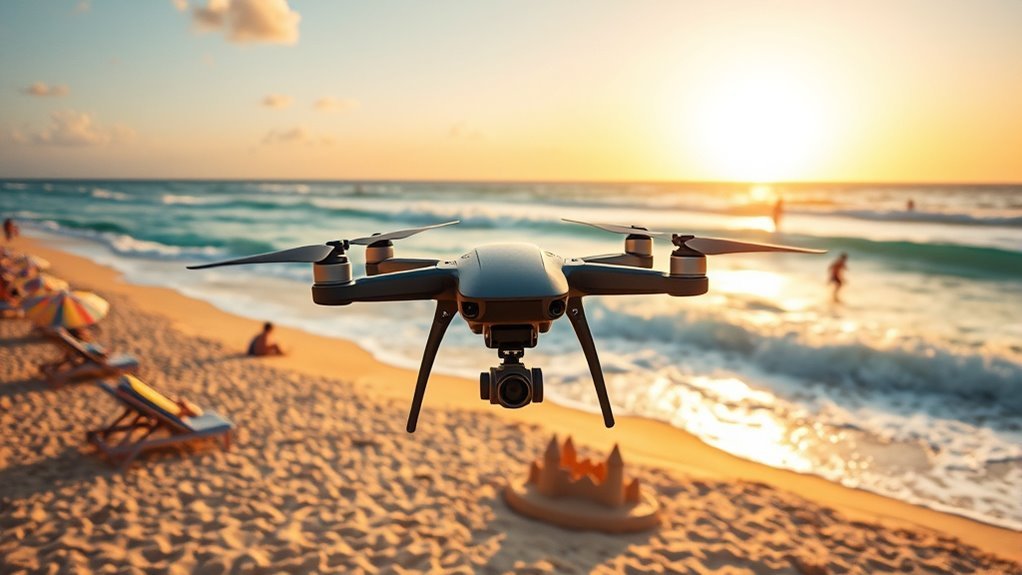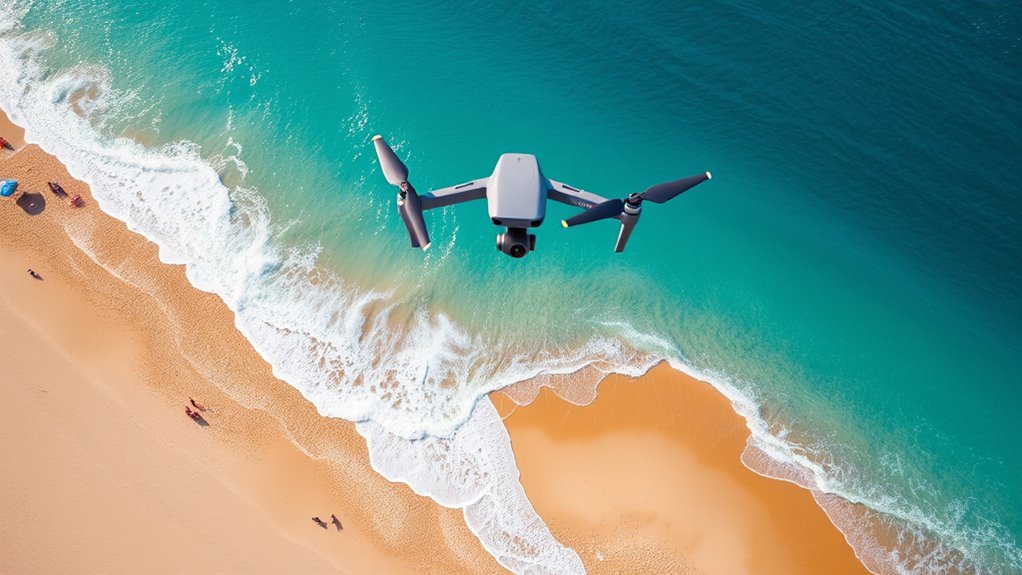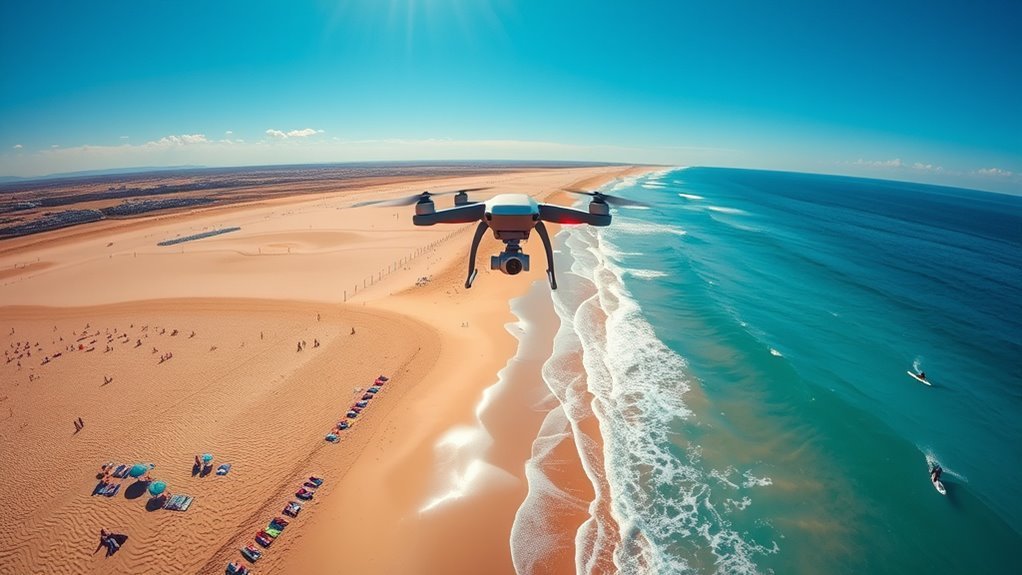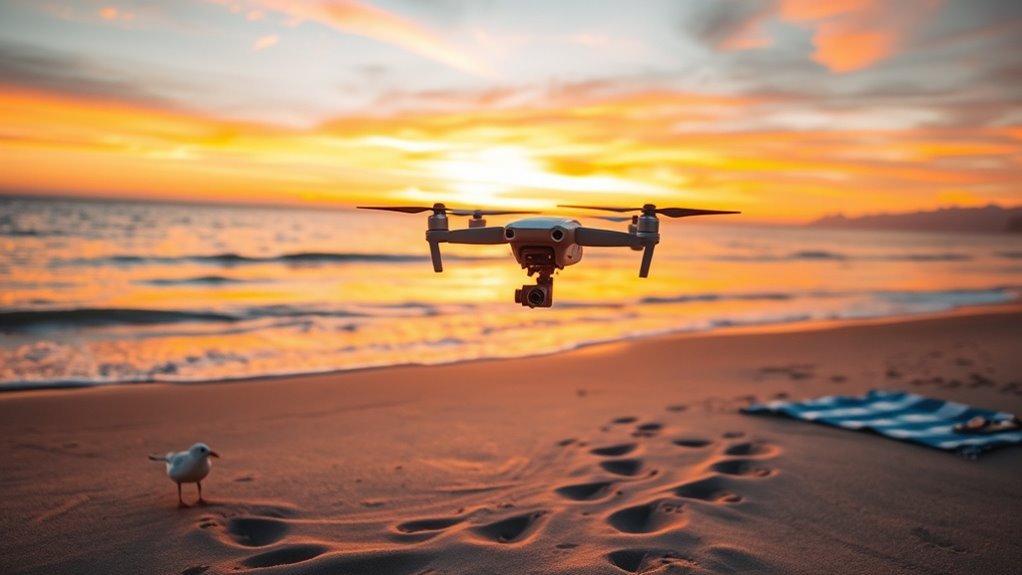You can fly a drone at the beach, but you first need to check local regulations and possible permits. Many beaches have specific restrictions, especially in crowded areas. Safety is essential, so keep a distance from people and wildlife. Ideal conditions include low wind speeds and good visibility. Be mindful of privacy and environmental concerns, too. There are more guidelines and tips to guarantee a smooth flying experience, so keep exploring!
Understanding Drone Regulations

When you’re considering flying a drone at the beach, it’s crucial to understand the regulations governing drone use in such areas. You’ll likely need drone permits, especially if you’re planning to capture stunning aerial footage or operate in crowded spaces. These permits help maintain safety and compliance with local laws. Enforcement agencies, such as the FAA, monitor drone activity to prevent accidents and protect wildlife. Familiarize yourself with the specific rules applying to your chosen beach, as regulations can vary widely. Ignoring these guidelines may lead to fines or confiscation of your drone. To enjoy the freedom of flying, stay informed, and operate within the established legal framework to guarantee a safe and enjoyable experience.
Local Laws and Restrictions

Knowing the regulations is only part of the equation; local laws and restrictions can greatly impact your ability to fly a drone at the beach. Each beach may have specific regulations that dictate where and when you can operate your drone. It’s essential to check for any required drone permits and local beach regulations before taking off. Additionally, understanding drone safety features can help ensure you operate within legal boundaries and minimize risks during your flight.
| Beach Location | Drone Regulations |
|---|---|
| Malibu Beach | No drones allowed |
| Ocean City, NJ | Permits required |
| Clearwater Beach, FL | Restricted zones apply |
| Cape May, NJ | Drones permitted with permit |
Always respect these rules to guarantee a safe and enjoyable experience while flying your drone. Ignoring local laws can lead to fines or confiscation of your equipment.
Safety Considerations

While it might seem exciting to fly a drone at the beach, safety considerations are crucial for both you and those around you. Always prioritize drone safety by maintaining a safe distance from people, pets, and wildlife. Beaches often have unpredictable winds and changing weather, which can pose significant challenges. Additionally, be aware of beach hazards like sand, water, and nearby structures that could interfere with your flight. Avoid flying over crowded areas to minimize the risk of accidents. Remember that your drone’s noise might disturb others seeking peace. By being cautious and respectful, you can enjoy the freedom of flying while ensuring a safe environment for everyone at the beach.
Best Practices for Flying Drones
When flying a drone at the beach, it’s essential to follow local regulations to guarantee compliance and safety. You should also respect wildlife and avoid disturbing animals in their natural habitat. Finally, maintaining safe distances from people and structures will help you fly responsibly and enjoyably. Additionally, be aware that environmental conditions can impact radar signal propagation and detection, which is crucial for ensuring the safety of your flight. Understanding the flight time of your drone is also important, as it affects how long you can safely operate in coastal areas.
Follow Local Regulations
Before you take to the skies with your drone at the beach, it’s essential to familiarize yourself with local regulations governing drone usage. Each area might have specific rules, so knowing them can save you from fines or penalties. Here are three key points to reflect on:
- Drone Permits: Check if you need a permit to fly in certain beach zones. Some areas may require registration or special permissions.
- Flight Restrictions: Be aware of any no-fly zones, especially near airports or crowded areas where safety is a concern.
- Time Limits: Some beaches may restrict drone use during peak hours or events to guarantee the comfort of all beachgoers.
Respect Wildlife Disturbance
As you prepare to fly your drone at the beach, it’s essential to take into account the impact on local wildlife. Respecting wildlife disturbance is vital for their protection and your drone etiquette. Avoid flying near nesting birds or marine animals, as your drone can frighten them and disrupt their natural behaviors. Here are some best practices to keep in mind:
| Best Practices | Description |
|---|---|
| Observe from a Distance | Keep your drone at a safe distance from wildlife. |
| Avoid Nesting Areas | Steer clear of known nesting sites during breeding seasons. |
| Time Your Flights | Choose times when wildlife is less active, like early mornings. |
Maintain Safe Distances
Maintaining safe distances while flying your drone is key to ensuring not only the protection of wildlife but also the safety of beachgoers and yourself. To achieve this, consider the following best practices:
- Respect drone altitude: Keep your drone at a safe height, generally above 100 feet, to avoid interfering with people and wildlife.
- Plan your flight patterns: Avoid flying directly over crowds or nesting areas; instead, create flight paths that minimize disturbances.
- Monitor your surroundings: Stay aware of changing conditions, such as wind or people moving, to adjust your altitude and patterns accordingly.
Ideal Weather Conditions
When flying a drone at the beach, it’s essential to take into account the weather conditions. Wind speed can greatly impact your drone’s stability, while temperature and humidity affect battery performance. Additionally, make sure you have good visibility and lighting to capture the best footage and navigate safely.
Wind Speed Considerations
Although flying a drone at the beach can be an exhilarating experience, wind speed plays an essential role in ensuring a safe and successful flight. High winds can compromise drone stability and make controlling your device challenging. Before you take off, consider these key factors:
- Wind Speed: Ideally, keep it under 15 mph. Anything higher can risk losing control.
- Wind Direction: Be aware of prevailing winds, as they can push your drone away from you, complicating your return.
- Gusts: Sudden gusts can occur near the shore, so monitor your surroundings closely.
Temperature and Humidity
While it might be tempting to fly your drone at the beach on a sunny day, temperature and humidity can greatly impact your flight experience. High temperatures can lead to increased battery drain, while excessive humidity can affect both the drone’s electronics and propeller performance. Understanding these factors is essential for a successful flight.
| Temperature Effects | Humidity Impact |
|---|---|
| Overheating potential | Moisture on components |
| Reduced battery life | Increased weight |
| Limited altitude gain | Control sensitivity |
| Shorter flight time | Risk of malfunctions |
To truly enjoy your freedom in the skies, keep an eye on the weather. Ideal conditions mean safer flights and more stunning views.
Visibility and Lighting
Weather conditions aren’t just about temperature and humidity; visibility and lighting play a major role in your drone flying experience at the beach. Ideal drone visibility is essential for safe navigation and capturing stunning footage. Here are three factors to take into account:
- Lighting Conditions: Early morning or late afternoon offers the best light for photography, reducing glare and enhancing colors.
- Clear Skies: Aim for days with minimal clouds and no fog to guarantee maximum visibility.
- Wind and Weather: Check for wind speed and weather alerts, as harsh conditions can affect both visibility and safety.
Popular Beach Destinations for Drone Flying
When planning to fly a drone at the beach, choosing the right destination can enhance your experience considerably. Popular drone spots like California’s Pismo Beach and Florida’s Daytona Beach offer stunning views and ample space. However, you must be aware of beach drone regulations that vary by location. Many beaches restrict drone flying in crowded areas or during specific hours, so always check local rules before you go. Additionally, consider beaches with fewer visitors for a more relaxed experience. Places like Cape May in New Jersey or the Outer Banks in North Carolina provide beautiful backdrops while allowing more freedom. Researching these popular destinations will help guarantee a fantastic and hassle-free drone flying adventure.
Respecting Privacy and Personal Space
When flying a drone at the beach, it’s important to be aware of personal space and the privacy of others. You should always keep a respectful distance from people and their belongings to avoid intruding on their experience. Additionally, familiarize yourself with local privacy laws to guarantee you’re not violating anyone’s rights while enjoying your flight.
Personal Space Awareness
Flying a drone at the beach can be an exhilarating experience, but it’s essential to respect the personal space and privacy of others around you. Being aware of your surroundings helps maintain a harmonious atmosphere. Here are some key points to take into account for personal space awareness:
- Maintain Distance: Keep your drone at a safe distance from people, respecting their personal boundaries.
- Observe Crowds: Be mindful of crowded areas; flying too close can disrupt others’ enjoyment and invade their space.
- Seek Permission: If you want to capture footage of individuals, ask for their consent first to guarantee their comfort.
Privacy Laws Considerations
While enjoying the freedom of flying a drone at the beach, you must be aware of privacy laws that protect individuals from unwanted surveillance. Drone surveillance can easily infringe on the privacy of others, so it’s essential to respect their personal space. Always consider beach etiquette: avoid flying your drone too close to sunbathers, families, or groups gathered on the sand. Many areas have specific regulations prohibiting drone use in certain zones, often for privacy reasons. Before you take off, familiarize yourself with local laws and guidelines. By being mindful of privacy concerns, you can enjoy your drone flying experience while ensuring everyone around you feels comfortable and respected. Remember, freedom goes hand in hand with responsibility.
Environmental Impact of Drone Usage
Although drones can offer stunning aerial views and enhance recreational activities at the beach, their environmental impact is a growing concern. You should consider the following points about drone usage:
- Drone Pollution: Drones can contribute to noise pollution, disturbing both wildlife and beachgoers, which may lead to a less enjoyable experience for everyone.
- Ecosystem Disruption: The flight paths of drones can intrude on natural habitats, potentially displacing sensitive species that rely on the beach environment.
- Wildlife Stress: The presence of drones can cause stress in animals, particularly nesting birds, which may abandon their nests due to disturbances. In addition, reduced GPS signal reliability in coastal areas may further complicate drone operation, increasing the chances of unintended disruptions.
Being mindful of these factors guarantees you enjoy your freedom while respecting the delicate balance of the beach ecosystem.
Tips for Capturing Stunning Aerial Photos
Capturing stunning aerial photos at the beach requires more than just taking off and snapping shots. Start by familiarizing yourself with essential aerial photography techniques. Use your drone’s camera settings to adjust exposure and focus for the best results. Pay attention to lighting; early morning or late afternoon provides softer, more dramatic light.
Composition tips are vital—try the rule of thirds to create balanced images. Incorporate interesting elements like waves or beachgoers to add depth. Experiment with different angles and altitudes to find the most engaging perspectives. Additionally, consider the control range of your drone to ensure you can capture images from a distance without losing connection. The dynamic range of your drone’s camera can significantly enhance the overall quality of your images. Finally, always keep an eye on your surroundings to guarantee safety and compliance with local regulations. With these strategies, you can release your creativity and capture breathtaking aerial imagery.
Resources for Drone Pilots
As you commence your journey as a drone pilot, having the right resources at your fingertips is fundamental for both safety and skill development. Here are three key resources to take into account:
- Drone Maintenance Guides: Regular maintenance is essential. Familiarize yourself with your drone’s requirements to guarantee peak performance and longevity. Understanding maintenance practices is crucial for extending your drone’s lifespan.
- Flight Insurance Options: Protecting yourself and your investment is critical. Look into insurance plans that cover damages and liability, providing peace of mind while you explore the skies.
- Online Communities: Engage with fellow drone enthusiasts. Forums and social media groups can offer invaluable tips, experiences, and support as you navigate both challenges and successes in piloting. Additionally, understanding battery types can significantly influence your drone’s flight time and overall performance.
Frequently Asked Questions
Can I Fly My Drone at Night on the Beach?
You can fly your drone at night, but check local beach regulations first. Some areas restrict night flights for safety and wildlife protection. Always prioritize safety and respect the rules to enjoy your freedom responsibly.
What Type of Drones Are Best for Beach Environments?
When the tide comes in, it’s wise to choose waterproof drones for beach environments. Lightweight models not only enhance portability but also guarantee durability against sand and water, giving you the freedom to explore safely.
Do I Need a License to Fly a Drone at the Beach?
You might need a license to fly your drone, depending on local regulations. Always check drone regulations and prioritize beach safety to guarantee you’re flying responsibly and enjoying your freedom without any legal issues.
Can I Fly a Drone Over Crowded Beach Areas?
Flying a drone over a bustling crowd’s like weaving through a maze. You’ve gotta prioritize crowd safety and practice good drone etiquette. Avoid flying too low or close to people to keep everyone safe and happy.
Are There Drone Flying Clubs or Communities Near Popular Beaches?
Yes, there’re drone meetups near popular beaches, but you should check local beach regulations first. Connecting with local communities can enhance your experience while ensuring you’re flying responsibly and within the law. Enjoy your freedom!

